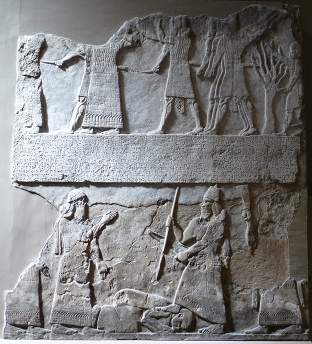RINAP History

A stone orthostat from the palace of Tiglath-pileser III at Kalḫu.British Museum, WA 118933. Photo by Karen Radner.
While the idea to assemble and publish standard, reliable editions of all of the official inscriptions of the rulers of ancient Mesopotamia had been germinating for a long time in the mind of A. Kirk Grayson, it first blossomed in the late 1970s when John A. Brinkman (University of Chicago) and Edmond Sollberger (British Museum) joined Grayson in two workshops at the University of Toronto [http://www.utoronto.ca/]. The theme of those workshops was the Royal Inscriptions of Mesopotamia (RIM) and the means by which those texts could be published in standard editions available to specialists and laymen alike. That project's general description grew out of those workshops. The basic methodology that would be used to edit the official inscriptions was thoroughly discussed at another series of workshops involving a select group of international scholars at the University of Toronto between 1979 and 1982. Rykle Borger (Göttingen), Veysel Donbaz (Istanbul), Paul Garelli (Paris), Louis D. Levine (Toronto), Fawzi Rashid (Baghdad), and Ronald F.G. Sweet (Toronto) attended. From those meetings grew the entire structure of the RIM Project and a detailed document, the Editorial Manual, in which the research methods and plans were laid down. When the RIM Project began, no similar project on that scale had ever been attempted in Assyriology.
In 1981, RIM was awarded full funding by the Negotiated Grants Section of the Social Sciences and Humanities Research Council of Canada [http://www.sshrc-crsh.gc.ca/] (SSHRC). During the next twenty-five years, that project was supported by grants from SSHRC, the University of Toronto, and private individuals. The last volume (RIME 1 [http://www.eisenbrauns.com/item/FRAPRESAR] by Douglas R. Frayne) appeared in print in 2008. In total, RIM produced ten volumes in its four sub-series.
Grayson retired from the University of Toronto in 2000 and after a few years, found it necessary to stop scholarly work. He then turned over the daily management of the RIM Project to Grant Frame, who had been associated with the project since 1980, assistant director since 1988, and acting director whenever Grayson had been on sabbatical. When Frame moved to Philadelphia in 2006 to take up an academic position in the Department of Near Eastern Languages and Civilizations [http://www.sas.upenn.edu/nelc/] at the University of Pennsylvania [http://www.upenn.edu/], Grayson asked him to take over the directorship of the project and passed on all of the RIM Project's files. Because the RIM Project had been under the administrative sponsorship of the Department of Near and Middle Eastern Civilizations [http://nmc.utoronto.ca] at the University of Toronto and since there was no longer anyone on the permanent faculty of that department working on the project, in consultation with the current chair of that department (Professor Linda Northrup), it was decided that the work carried on by Frame should be done under another name, thus the formation of the Royal Inscriptions of the Neo-Assyrian Period (RINAP) Project.
Frame applied for National Endowment for the Humanities [http://www.neh.gov/] (NEH) support for the RINAP Project in 2007 and was awarded a two-year grant. Thus, the project officially began on July 1, 2008. In 2010, 2012, 2015, and 2017, the Division of Preservation and Access [http://www.neh.gov/divisions/preservation] of the NEH also awarded RINAP two-year grants to publish the inscriptions of rulers of Assyria from 744 BC to 609 BC. From 2015–23, the Alexander von Humboldt Foundation and Ludwig-Maximilians-Universität München (Historisches Seminar – Abteilung Alte Geschichte), through the establishment of the Alexander von Humboldt Chair for Ancient History of the Near and Middle East for Karen Radner, also provide financial support for RINAP, mostly in connection with the inscriptions of Ashurbanipal and his successors, but also from those of Sargon II. In addition, the Gerda Henkel Foundation (2019–22) gave funding for the completion of the final two volumes of the series. The project was envisioned as an thirteen-year project (2008–23).
Jamie Novotny
Jamie Novotny, 'RINAP History', The Royal Inscriptions of the Neo-Assyrian Period, The RINAP Project, 2023 [http://oracc.museum.upenn.edu/rinap/abouttheproject/rinaphistory/]